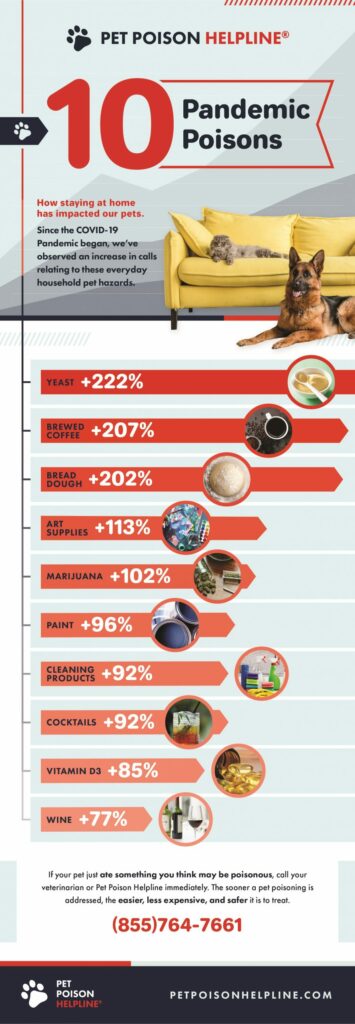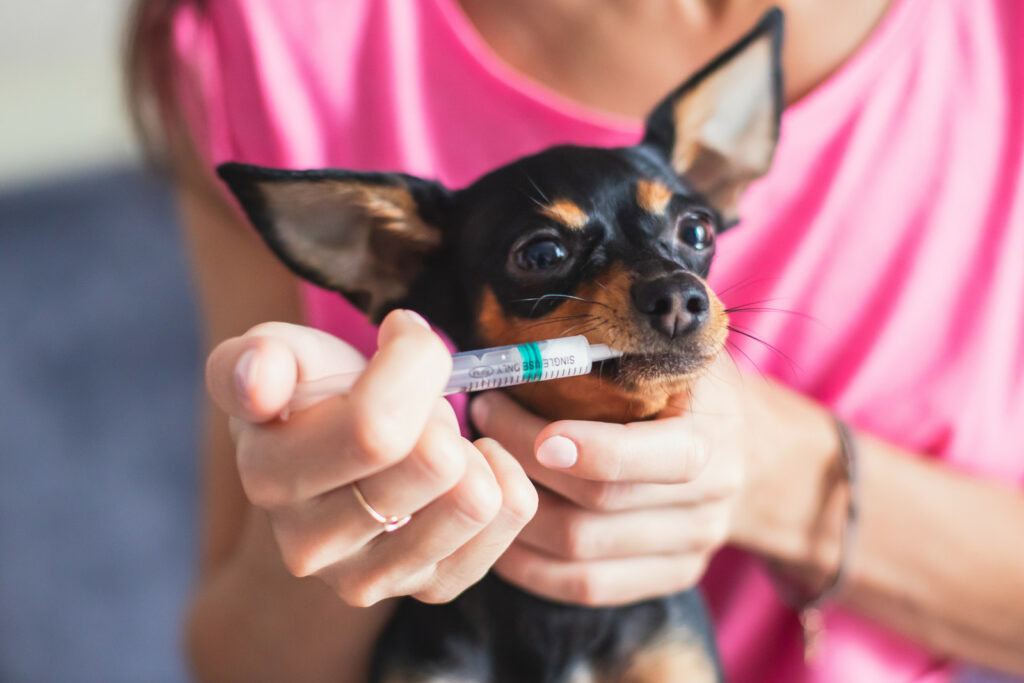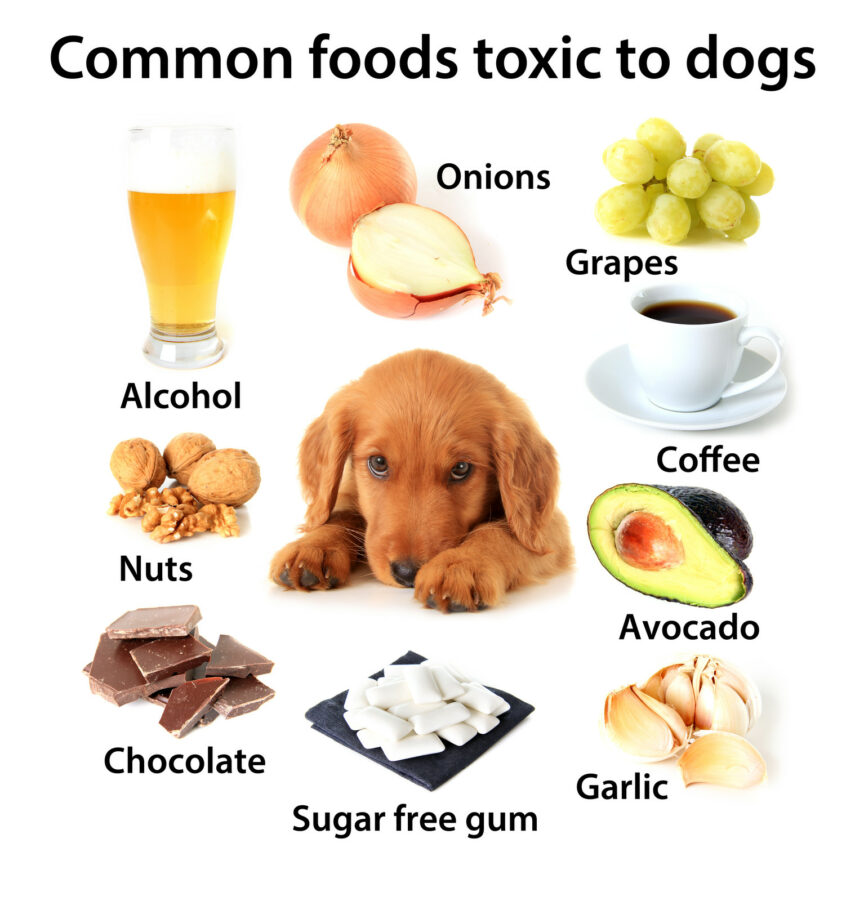By Arden Moore
Pro Pet Hero Instructor Director and Master Pet First Aid/CPR Instructor
With more people getting vaccinated against COVID-19 and cases dropping in numbers, it is finally safer to venture outdoors with our dogs this summer. Sure, our dogs loved having us at home 24-7, but a new report indicates major spikes in the incidents of dogs and cats being poisoned accidentally.
Ingredient That Topped the Danger List for 2020
Many pet owners are aware of the dangers of their pets ingesting dark chocolate and sugar-free peanut butter, but many may be surprised by the ingredient that topped the danger list for 2020: yeast.
“Baker’s yeast and bread dough are in our top three types of cases that increased more than 200 percent during the pandemic,” reports Ahna Brutlag, DVM, a board-certified veterinary toxicologist at Pet Poison Helpline. “While that sourdough bread smells and tastes great, the yeast in the starter and raw dough can be toxic to your pet. When ingested, it can lead to both stomach bloat and alcohol poisoning in cats and dogs. Both can be life-threatening.”
That 222-percent increase in yeast incidents were over a one-year period, from March 2020 to February 2021, according to this animal poison control center based in Minneapolis.
“We always saw a 102-percent increase in the number of marijuana poisoning cases referred to our veterinary toxicology experts,” adds Dr. Brutlag. “There was also a significant increase in pets exposed to cocktails and wine (92 and 77 percent increases, respectively.)”
Top 10 Pandemic Poisons
Check out this graphic that indicates the top 10 items with the sharpest increases in incidents impacting pets during the pandemic:

Inducing Vomiting
As I teach in our two-day Pro Pet Hero instructor program and my Pet First Aid 4U classes, you may need to induce vomiting in a dog or cat who has swallowed a toxin, but is not able to purge this poison. Before you reach for that bottle of 3% hydrogen peroxide, always consult your veterinarian or the Pet Poison Helpline first so you do not cause more harm to your pet.
The general guideline calls for giving the pet 1 teaspoon of hydrogen peroxide per 10 pounds of body weight. So, a 30-pound dog would require 3 teaspoons to effectively induce vomiting to rid the body of the swallowed toxin.
Here’s an easy and quick way to accurately measure: Using a teaspoon, measure out three teaspoons of hydrogen peroxide into a clean coffee mug or a small bowl. Use a plastic syringe to pull out the hydrogen peroxide from the container. Next, position your pet with him facing away from you for safety and have him on an easy-to-clean surface like a tile or wooden floor.

Open your pet’s mouth from the side. The best place to position that syringe is that pocket on the side just past the big canine tooth and two small teeth. Then close the pet’s muzzle, elevate his head slightly and rub his throat to help him swallow the hydrogen peroxide. When you see the tongue coming out, that’s a good sign he has swallowed.
Based on what your veterinarian tells you to do, you may need to give a second dose 10 to 15 minutes later, but never more than two doses. Gather a sample of the induced vomit to bring to the clinic for your veterinarian to analyze. Secure your dog or cat safely in the back seat for transport.
Tips from a Veterinarian
One of my veterinary heroes is Justine Lee. She is board-certified in critical care and emergency medicine plus toxicology. She is the founder of VETgirl and host of a podcast called ER Vet on Pet Life Radio.
She offers these two additional tips if you don’t have a pet first aid kit handy and the veterinary clinic is far away.
* Reach for a bottle of liquid dish soap (such as Dawn) to safely remove any potentially poisonous chemical or toxin from a dog or cat’s fur. For example, if your cat accidentally had a dog flea and tick medication put on it, you’ll need to bath off this chemical immediately to prevent tremors and seizures. Likewise, if your pet rolled in something poisonous (like motor oil), you can safely bath it off with liquid dish soap.
* Keep on hand a can of canned tuna (in water) or a can of chicken broth. Several plants (such as Dieffenbachia, Poinsettias), household products (such as glow sticks) and household cleaners can cause severe foaming and drooling of the mouth due to irritation. By simply diluting the taste or chemical out of your pet’s mouth with something tasty (like the water from the tuna), it can safely flush out the mouth and esophagus. This is much safer than using a spray or hose to flush out the taste from your pet’s mouth, as there is a chance your pet could aspirate that fluid into their lungs.
To learn more from Dr. Lee, here is the link to her recent guest appearance on my pet podcast called the Oh Behave Show on Pet Life Radio. Click here to listen.
Pet Poison Helplines
There are actually two pet poison helpline companies staffed by veterinary toxicologists 24 hours a day. You can call the Pet Poison Helpline at 800-213-6680 or the ASPCA Animal Poison Control Center at 888-426-4435. Please be aware that both charge fees.
Learn How to Keep Your Pet Safe
Learn more on ways to keep your dogs and cats safe by visiting http://www.propethero.com. Consider taking our veterinarian-approved online pet first aid/CPR course. Enter this code: CPR – ARDEN MOORE and receive a 10 percent discount! And, if you are interested in becoming a Pro Pet Hero instructor, please click on the BECOME AN INSTRUCTOR button on the home page for more details.

